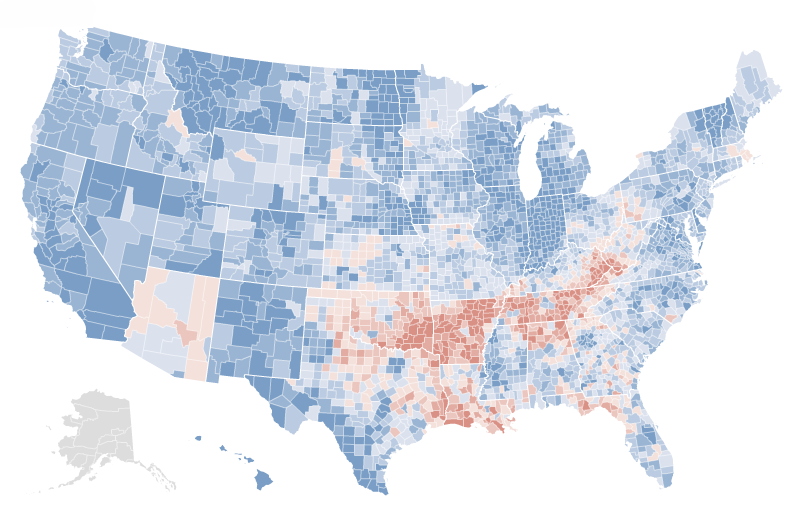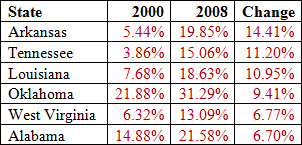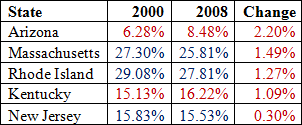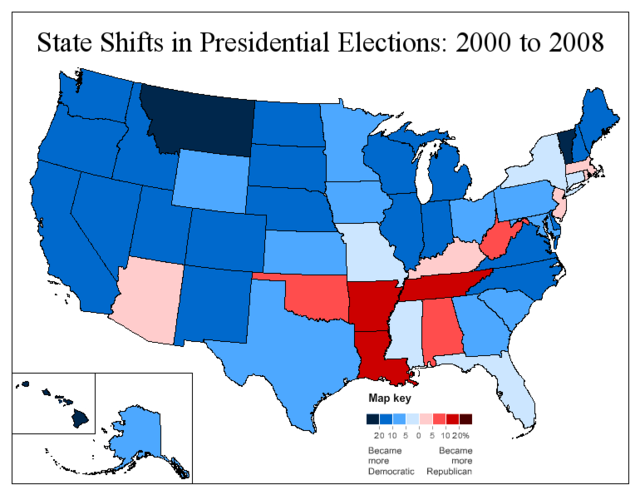I decided to do a partisan gerrymander for the contest which pretty much locks in 26 Democrats and 2 Republicans for the state. All 26 Democratic seats were won by Obama with at least 58% of the vote, and McCain got at most 41%. This is, in effect, making each Democratic district at least a “+10 D” seat since Obama beats McCain by at least a 17 point margin for each of the 26 seats, while Obama beat McCain nationally by about 7 points, and essentially assures that a Democrat will represent each of the 26 seats in Congress.
The remaining two seats are ceded to the GOP. One is NY-26 in western New York, and the other is a reconfigured NY-24 in the eastern part of upstate. It was sad to sacrifice Michael Arcuri in this manner, but it makes all the neighboring seats safe and then some, by spreading more Democrats outward to other seats. It’s nothing personal against Arcuri; it was just easiest to do it this way for me geographically, and since Arcuri had a hard time at reelection in 2008, he may not be that safe in future elections anyhow.
Despite the highly gerrymandered lines, each district strives to maintain at least a decent portion of the territory currently in the district (including, ofcourse, each incumbent’s home). The notable exceptions are Arcuri’s district (discussed under NY-24 below) and Peter King’s district on Long Island, which is obliterated. About 26% of King’s district becomes part of NY-2; about 26% becomes part of NY-4; 8% goes to NY-5, and 5% to NY-18. (The Democratic percentage in NY-2 and NY-4, nevertheless, goes UP to 60% Obama in each district, while remaining above the 60% level in both NY-5 and NY-18).
The largest part of the current NY-3, about 35% (including King’s home in Seaford/Oyster Bay) goes to NY-6, but King would have no chance there, as the district is 50%+ African-American and voted 71% for Obama. Thus, King’s district is geographically torn into pieces and destroyed.
In the meantime, Eric Massa’s NY-29 in upstate is renamed NY-3 (thanks to MattTX2 for the inspiration from his contest entry ! as well as the inspiration for intertwining upstate districts in the eastern part of the state with areas in metro NYC. Btw, as far as I’m concerned, I’m OK if others take parts of my plan to use in their remaps. I mean, I like the competition of the contest, but one goal for us all is to draw the best map possible for New York and show just what can be done.)
Several technical notes:
BIG NOTE TO CONTEST JUDGE: please note that in the drf.xml file I sent you (and reflected on the maps here) I have switched districts 5 and 6 because of the better color differentiation (yellow/green) from neighboring districts on the maps. So, what’s tagged as “District 5” in the program is really District 6 … and vice versa.
I decided to have an even stricter population difference than the contest calls for; all my districts vary by no more than 2,000 persons from the ideal population; the contest rules accept up to around 7,000. However, I have 1,760 persons unaccounted for in my plan. Yes, I know to use the “next unassigned” button, but the program just can’t seem to find the missing geographical bits (I was successful at finding a bunch of missing precincts through “unassigned”, but with the last 1,760 persons, it just points to areas already designated for a specific district). Anyhow, the missing area(s) voted 84% for Obama, so perhaps one of my districts could be even more Democratic than what’s in this plan ? oh well !)
Here’s my plan:
MAPS:



District 1:
Incumbent: Timothy Bishop
Current District: Obama 52; McCain 48
Proposed District: Obama 59; McCain 41
Population: 701,005
Demographics: white 70; black 11; native am. 0; asian 2; hispanic 15; other 2
Encompasses the eastern half of Long Island. Entire district is confined to Suffolk Co., mostly the eastern portion but with some very Democratic areas in western Suffolk added (parts of Islip and Babylon) to bring up the Democratic percentage.
District 2:
Incumbent: Steve Israel
Current District: Obama 56; McCain 43
Proposed District: Obama 60; McCain 40
Population: 701,072
Demographics: white 67; black 15; native am. 0; asian 3; Hispanic 12; other 2
The new district is centered on western Suffolk Co. and eastern Nassau Co., including most of Huntington, and parts of Babylon, Islip, Oyster Bay and Hempstead. The Democratic percentage goes up with the addition of very Democratic areas in Hempstead.
District 3 (Old 29):
Incumbent: Eric Massa
Current District: Obama 48; McCain 51
Proposed District: Obama 58; McCain 41
Population: 700,442
Demographics: white 87; black 8; native am. 0; asian 2; hispanic 2; other 1
The current NY-29 is renamed NY-3. The new district encompasses parts of Buffalo and Erie Co., then stretches south and east along the Pennsylvania border to include Massa’s home in Corning, and then goes northeast to include the Ithaca area. Adding Ithaca and parts of Buffalo makes the district a lot more Democratic, and I think including Ithaca is a nice complement for the progressive Massa.
District 4:
Incumbent: Carolyn McCarthy
Current District: Obama 58; McCain 41
Proposed District: Obama 60; McCain 40
Population: 701,554
Demographics: white 58; black 11; native am. 0; asian 11; hispanic 15; other 6
The district retains much of the current territory in Nassau, including McCarthy’s home in the Mineola part of North Hempstead, but the borders are made more gerrymandered in order to maintain the current Democratic advantage. In order to make the district overall even more Democratic than the current version, part of the district is extended into Queens.
District 5:
Incumbent: Gary Ackerman
Current District: Obama 63; McCain 36
Proposed District: Obama 63; McCain 37
Population: 698,427
Demographics: white 43; black 6; native am. 0; asian 22; hispanic 27; other 2
The new district is quite similar to the current one, including parts of Queens and northern Nassau Co. (North Hempstead). The district is extended eastward a bit, further into northern Nassau (northern part of Oyster Bay), but loses some southern areas in Queens and Nassau. The partisan breakdown remains very much the same.
District 6:
Incumbent: Gregory Meeks
Current District: Obama 89; McCain 11
Proposed District: Obama 71; McCain 29
Population: 701,198
Demographics: white 38; black 50+; native am. 0; asian 1; hispanic 7; other 3
The new NY-6 contains much of the territory of the current NY-6 (Jamaica, St. Albans, etc.), but is reconfigured in a manner to maximize the obliteration of Peter King’s district. Basically, the most Democratic parts of NY-6 are combined with the most Republican parts of NY-3 (including King’s home base).
Despite the new unorthodox appearance with the district hugging the water in many areas, a person can actually walk from one part of the district to any other part via land or bridges. You start out in the Queens heart of the district; can walk west into the Brooklyn extension or take the Cross Bay Blvd. south over Jamaica Bay to the Rockaway area (Meeks home is in Far Rockaway); then go east along the Atlantic shore, hop over another bridge to Long Beach (the district is very narrow here, btw, only one precinct deep hugging the ocean); from there you can hop over several more bridges and islands to Jones Beach Island. Then, you can go in either of two directions. 1.) Go further east towards Oak Beach, and can then go over the Robert Moses Causeway either south to Fire Island or north to the Long Island mainland around West Islip where part of the district continues along the shore back towards Amityville, or 2.) go north from Jones Beach Island across Wantagh State Parkway to the mainland and Seaford/Oyster Bay — what today is the heart of NY-3 and Peter King’s base in Nassau.
District 7:
Incumbent: Joseph Crowley
Current District: Obama 79; McCain 20
Proposed District: Obama 73; McCain 27
Population: 699,421
Demographics: white 51; black 10; native am. 0; asian 9; hispanic 26; other 4
Contains parts of Queens (Astoria, part of Woodside), Brooklyn (Greenpoint, part of Williamsburg) and parts of the Bronx and Manhattan. All areas are connected by land or bridges – specifically, the series of highways and bridges on Randalls Island connects the Bronx, Manhattan and Queens parts of the district which are across water from each other. The Democratic percentage goes down somewhat, but the district remains very safely Democratic.
District 8:
Incumbent: Jerrold Nadler
Current District: Obama 74; McCain 26
Proposed District: Obama 73; McCain 26
Population: 700,314
Demographics: white 59; black 6; native am. 0; asian 17; hispanic 14; other 4
The new district contains territory same as or similar to the current district – a combination of very progressive areas in Manhattan (Nadler’s home base on the Upper West Side, Chelsea, Tribeca) and relatively more conservative parts of Brooklyn (areas like Bensonhurst and Bay Ridge). The Brooklyn Bridge connects the Manhattan and Brooklyn parts of the district. The partisan breakdown does not change much.
District 9:
Incumbent: Anthony Weiner
Current District: Obama 55; McCain 44
Proposed District: Obama 60; McCain 40
Population: 698,687
Demographics: white 55; black 10; native am. 0; asian 15; hispanic 16; other 5
The new NY-9 contains parts of Queens (including Weiner’s home in Forest Hills), Brooklyn, and Nassau Co. The Democratic percentage goes up, as the district no longer includes most of the Orthodox Jewish conservative parts of Brooklyn.
District 10:
Incumbent: Edolphus Towns
Current District: Obama 91; McCain 9
Proposed District: Obama 80; McCain 19
Population: 700,702
Demographics: white 32; black 50+; native am. 0; asian 4; hispanic 11; other 3
The new Brooklyn-based district is largely similar to the current one, and includes areas like Bedford-Suyvesant, parts of Canarsie and East New York. The Democratic percentage goes down as the new district expands to include more conservative parts of Brooklyn (including Orthodox Jewish areas), and into more GOP-friendly territory on the Rockaway peninsula in Queens.
District 11:
Incumbent: Yvette Clarke
Current District: Obama 91; McCain 9
Proposed District: Obama 76; McCain 24
Population: 701,845
Demographics: white 33; black 50+; native am. 0; asian 4; hispanic 9; other 3
Similar situation to NY-10 above; Brooklyn-based district; newly added Orthodox Jewish areas make the Democratic percentage go down, but at 76% Obama, it’s a very safe Democratic seat. The new district includes African-American majority areas east of Prospect Park, the eastern part of Flatbush and Brownsville, then extends to the Orthodox areas around Ocean Parkway and Borough Park, and goes south all the way south to Brighton Beach.
District 12:
Incumbent: Nydia Velázquez
Current District: Obama 86; McCain 13
Proposed District: Obama 85; McCain 15
Population: 698,381
Demographics: white 20; black 12; native am. 0; asian 14; hispanic 50+; other 4
The new district is concentrated along the Brooklyn-Queens border. It expands north further into Queens, and also goes across Manhattan Bridge from Brooklyn to include part of the Lower East Side of Manhattan. The Hispanic percentage increases from the current 48% to 50%+.
District 13:
Incumbent: Michael McMahon
Current District: Obama 49; McCain 51
Proposed District: Obama 61; McCain 39
Population: 699,033
Demographics: white 63; black 9; native am. 0; asian 6; hispanic 20; other 2
The new NY-13 includes all of Staten Island. It then goes over the Verrazano Bridge to include some of the most Democratic (though mostly non-minority) areas in Brooklyn including parts of Park Slope, Brooklyn Heights and Sunset Park. No inclusion of any part of Manhattan was necessary to increase the Democratic percentage significantly (again, thanks to MattTX22 for the inspiration !).
District 14:
Incumbent: Carolyn Maloney
Current District: Obama 78; McCain 21
Proposed District: Obama 81; McCain 18
Population: 701,165
Demographics: white 70; black 4; native am. 0; asian 15; hispanic 9; other 2
The new district is now confined entirely to Manhattan, as the Queens areas are taken out. The district includes areas like the Upper East Side, Midtown and the East Village. It becomes marginally even more Democratic than the current progressive stronghold.
District 15:
Incumbent: Charles Rangel
Current District: Obama 93; McCain 6
Proposed District: Obama 79; McCain 20
Population: 699,529
Demographics: white 29; black 26; native am. 0; asian 3; hispanic 40; other 2
The new district includes Harlem and other areas in northern Manhattan. It then follows Broadway out into the Bronx, and then Highway 87 up through Yonkers, and into Rockland Co. The district remains minority-majority (71%) though, as with the current district, no racial/ethnic group has a clear majority by itself.
District 16:
Incumbent: José Serrano
Current District: Obama 95; McCain 5
Proposed District: Obama 93; McCain 7
Population: 700,289
Demographics: white 5; black 30; native am. 0; asian 2; hispanic 60; other 2
Remains similar to the current district, including much of the South Bronx and central parts of the Bronx around the zoo. The Hispanic percentage remains at the 60% level required by the contest rules.
District 17:
Incumbent: Eliot Engel
Current District: Obama 72; McCain 28
Proposed District: Obama 63; McCain 36
Population: 699,291
Demographics: white 65; black 10; native am. 0; asian 3; hispanic 20; other 2
The new district includes much of the same territory in the Bronx (including Engel’s home in Riverdale), and Westchester and Rockland Counties, but also expands north into more conservative areas upstate (parts of Orange, Sullivan, Delaware and Broome Counties) as well as south into more progressive areas on the west side of Manhattan. In effect, the new district forms most of New York’s border with New Jersey. The district becomes somewhat less Democratic, but is still very safe.
District 18:
Incumbent: Nita Lowey
Current District: Obama 62; McCain 38
Proposed District: Obama 61; McCain 39
Population: 700,775
Demographics: white 62; black 20; native am. 0; asian 3; hispanic 13; other 2
NY-18 remains very similar in partisan preference to the current district, but the borders change rather dramatically. Many parts of Westchester are still there (including Lowey’s home in Harrison, Rye and parts of New Rochelle), but the new district also includes a part of the northern Bronx and jumps across Long Island Sound to encompass northern parts of Long Island – most of Glen Cove, and areas east along the shore into Suffolk Co. (Smithtown and part of Brookhaven). I figured that Lowey might be OK with such a district, since back in the 1990’s she represented a district that also combined rather disparate areas (parts of Westchester combined with parts of the Bronx and Queens). Sorry, there’s no existing bridge to connect the two major parts of the new district (Westchester and Long Island) but there is a proposal to have a bridge or tunnel built (from Rye to Glen Cove and/or Oyster Bay) ! — http://en.wikipedia.org/wiki/L…
District 19:
Incumbent: John Hall
Current District: Obama 51; McCain 48
Proposed District: Obama 60; McCain 40
Population: 701,088
Demographics: white 60; black 11; native am.0; asian 4; hispanic 23; other 2
The new NY-19 becomes more Democratic as it’s extended southward towards NYC. The district runs from Hall’s home in Dover in the very northern part of the district, through Dutchess, Putnam and Westchester Counties (including parts of White Plains and New Rochelle) and then into a part of the northern Bronx. Inevitably the Democratic percentage goes up to levels where just about any Democrat should be safe.
District 20:
Incumbent: Scott Murphy
Current District: Obama 51; McCain 48
Proposed District: Obama 59; McCain 40
Population: 698,825
Demographics: white 75; black 13; native am. 0; asian 3; hispanic 7; other 2
In a fashion very similar to NY-19 described above, the NY-20 starts near Murphy’s home in Glens Falls, then follows the Hudson Valley south towards NYC, stopping just short of actually entering the city, but still including very Democratic Mount Vernon, just over the NYC line in Westchester.
District 21:
Incumbent: Paul Tonko
Current District: Obama 58; McCain 40
Proposed District: Obama 58; McCain 41
Population: 701,643
Demographics: white 81; black 7; native am. 0; asian 2; hispanic 8; other 2
The new district continues to include a good part of the Albany area, including Tonko’s home in Amsterdam, as well as all of Schenectady and parts of Albany. It then follows the Hudson Valley south to Peekskill, ending in Westchester and Rockland Counties. The partisan breakdown remains pretty much the same as the current district.
District 22:
Incumbent: Maurice Hinchey
Current District: Obama 59; McCain 39
Proposed District: Obama 58; McCain 41
Population: 700,768
Demographics: white 81; black 8; native am. 0; asian 2; hispanic 7; other 2
The new NY-22 is similar in many ways to the current district. It includes areas from Binghamton and Broome Co. to Hinchey’s home area in Ulster Co. around Hurley and Kingston. Also included are all of Chemung and Tioga Counties and parts of Chenago, Otsego, Delaware, Sullivan and Orange Counties, as well as Poughkeepsie and Beacon in Dutchess Co. The Democratic percentage here remains very similar to the current district.
District 23:
Incumbent: Bill Owens
Current District: Obama 52; McCain 47
Proposed District: Obama 58; McCain 41
Population: 700,802
Demographics: white 91; black 4; native am. 0; asian 1; hispanic 2; other 1
The new district combines the more Democratic parts of the current NY-23 (St. Lawrence, Franklin, Clinton and most of Essex Co.) with Democratic territory further south around Saratoga Springs and including most of Albany. Now, either Doug Hoffman or Jim Tedisco could try to run against Owens, but either would have a hard time, as the Democratic percentage goes up significantly.
District 24:
Incumbent: Michael Arcuri
Current District: Obama 51; McCain 48
Proposed District: Obama 44; McCain 54
Population: 700,042
Demographics: white 94; black 2; native am. 0; asian 1; hispanic 2; other 1
The new district includes a large swath of territory in the eastern part of upstate New York, including all or parts of 19 counties. Arcuri had a close call during his 2008 re-election bid, so it’s likely he would lose here. The new NY-24 actually includes much of Arcuri’s current territory (except, notably his home in Utica, which goes into the new NY-25 to make that district more Democratic), but the new partisan breakdown would be too much to handle. However, not all hope is lost. Perhaps Doug Hoffman, who lives just outside the borders of the new NY-24, can run here instead and we can have a repeat of NY-23 from this past November ! Most of DeDe Scozzafava’s legislative district is also included here, as is most of the district of State Senator Darrell Aubertine, who perhaps might be the only Democrat who could launch a possibly successful campaign here.
District 25:
Incumbent: Daniel Maffei
Current District: Obama 56; McCain 43
Proposed District: Obama 58; McCain 41
Population: 700,401
Demographics: white 86; black 7; native am. 1; asian 2; hispanic 3; other 2
NY-25 continues to include all of Syracuse and Onondaga Co. Also included under the new lines is most of Cayuga, Seneca, and Madison Counties, Geneva in Ontario Co., and
Utica in Oneida Co. The Democratic percentage goes up a bit. Even though Arcuri’s home in Utica is included here, as well as the counties west of Onondaga which are also currently in NY-24, most of the territory comes out of Maffei’s current NY-25, and the new district is designed with Maffei in mind.
District 26:
Incumbents: Christopher Lee
Current District: Obama 46; McCain 52
Proposed District: Obama 41; McCain 57
Population: 698,894
Demographics: white 95; black 2; native am. 0; asian 1; hispanic 2; other 1
This new district combines much of Lee’s base in Erie Co. with other hyper-Republican areas in the western part of upstate New York – including all or parts of 16 different counties. The Republican percentage goes up significantly, as the vast majority of GOP precincts in this part of the state are packed into the district
District 27:
Incumbent: Brian Higgins
Current District: Obama 54; McCain 44
Proposed District: Obama 58; McCain 41
Population: 700,771
Demographics: white 82; black 11; native am. 1; asian 1; hispanic 4; other 1
This Buffalo-based district remains very similar to the current configuration. The Democratic percentage is made higher with the addition of more of Buffalo. Also included are Niagara Falls, Tonawanda and areas south of Buffalo in Erie and Chautauqua Counties.
District 28:
Incumbent: Louise Slaughter
Current District: Obama 69; McCain 30
Proposed District: Obama 60; McCain 39
Population: 701,210
Demographics: white 77; black 13; native am. 0; asian 3; hispanic 5; other 2
This is one of the few districts that is actually made more compact by this plan. NY-28 is now almost completely confined to Rochester and Monroe Co. (including the most Democratic parts, ofcourse) with a sliver protruding south to Geneseo (home of SUNY-Geneseo) in Livingston Co. The Democratic percentage goes down, but the seat remains safe for a Democrat.
So that’s my plan for New York. Thanks.






